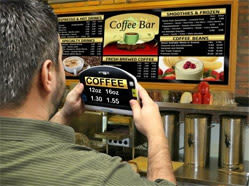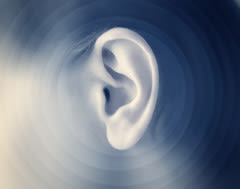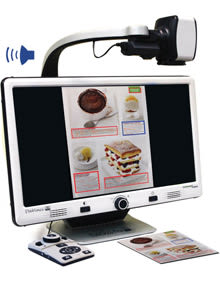Low Vision News And Products
DaVinci Pro HD/OCR: A Better Reading Experience For The Visually Impaired
November 2015 — Imagine how enjoyable reading can be with this new desktop video magnifier (CCTV) by Enhanced Vision that has both a high-performance camera for magnification and full-page text-to-speech (OCR) software. It's actually two devices in one.
The Sony Full HD 1080p auto-focus camera rotates for reading, distance viewing and self-viewing, and it magnifies up to 77x.
The 24-inch high-resolution HD LCD display pivots for best image quality and offers 28 viewing modes for optimal contrast and brightness. With the computer-compatible display you can toggle between a computer and the CCTV. And you can connect the display to an iPad or other tablet.
Push a button, and you switch from a live image to OCR. The OCR function includes a reading preview for either reading an entire page or navigating through paragraphs to read selected text. You can choose between male and female premium voices in many different languages. And you can save documents, books or pictures and export them to a computer. (Please click here for a close-up image.)
The DaVinci Pro HD/OCR is easy to set up — you just plug it in and begin. Phone and online support are available, and Enhanced Vision offers a two-year warranty for your peace of mind.
The Amigo HD: Portability And Versatility In One Package
March 2015 — Reading labels, menus, price tags and street signs can be really difficult for people with low vision, but the Amigo HD can help.

This hand-held electronic magnifier is about the size of a tablet and weighs just 1.3 pounds, with a 7-inch high-definition screen. It includes both auto-focus and one-push manual focus.
It has large, color buttons to help you choose magnification levels from 1.4x to 25x and the right color contrast for your needs. There are 28 available color modes, too. You can use the image-capture for easier viewing, and you can even upload images to a PC.
While it's extremely portable, the Amigo HD can also be used hands-free on a desktop, so you can read, write, pay bills and work on hobbies. It's available from Enhanced Vision or through your eye care provider.
Can Human Echolocation Replace Vision?
January 2015 — Some blind people use echolocation, a technique commonly associated with bats, to help compensate for lack of vision. They make sounds, often by snapping their fingers or clicking their tongue, and interpret the sound waves that bounce off objects to perceive their surroundings. However, not a lot is known about how echolocation compares with actual sight.

Scientists from the Brain and Mind Institute set out to compare echolocation's influence on blind people's perception with sighted individuals' perception. "Ironically, the proof for the vision-like qualities of echolocation came from blind echolocators wrongly judging how heavy objects of different sizes felt," explains Melvyn Goodale, Director of the Brain and Mind Institute.
The researchers found that blind people using echolocation were susceptible to visual illusions, just like sighted people. Their experiment included three groups of people: sighted people, blind echolocators and blind people not using echolocation. Each group lifted cubes of different sizes by strings and were asked which cube seemed heavier.
The blind group not using echolocation correctly judged that all the cubes weighed the same. But the sighted and echolocation groups both fell victim to the same illusion and overwhelmingly perceived the smaller cubes to be heavier. This optical illusion is known as the "Charpentier illusion."
The researchers concluded that "echolocation is not just a functional tool to help visually impaired individuals navigate their environment, but actually has the potential to be a complete sensory replacement for vision."
The complete study was published in the December issue of Psychological Science.
Read more about living with low vision.
Page published on Thursday, February 28, 2019







